Abstract
Objective:
This study was undertaken to evaluate the respective effectiveness of the horizontal scrub, Fones, and modified Bass methods demonstrated on the cast to individual child within the classroom setting.
Materials and Methods:
A total of 180 healthy children studying in 1st and 2nd grades in the age range of 6-8 years were randomly selected from various schools of Gulbarga district, Karnataka, India. They were equally divided into three groups. Children in each group were demonstrated only one of the three brushing techniques, viz. horizontal scrub technique to group A, Fones technique to group B, and modified Bass technique to group C, using a cast model. All the children were re-examined and reviewed after 24 h and plaque index was re-assessed to obtain the follow-up data. The results were compared with the baseline data, and statistical analysis was carried out using paired t-test and intergroup comparison was made using analysis of variance (ANOVA) test.
Results:
Statistically significant (P < 0.001) reduction in plaque score was seen in modified Bass technique followed by horizontal scrub technique and the least efficacy was seen in Fones technique.
Conclusion:
This study showed that modified Bass technique was the most effective brushing technique in children.
Keywords: Children, dental plaque, tooth brushing techniques
INTRODUCTION
The most common dental problem of concern in school going children is dental caries. The reported prevalence of dental caries in 6-year-old children in Karnataka is 57.20%.[1] Dental plaque is considered as the possible causative agent of the major dental diseases such as caries and periodontal disease. Plaque as an etiologic agent was first identified in a classic study by Loe et al. in 1965, where it was demonstrated that there was development of gingivitis within a few days of stopping oral hygiene practices. It was attributed to the shift to gram-negative plaque flora, and it was noted that gingivitis was reversible when patients resumed their oral hygiene procedures. The use of preventive procedures to maintain optimal oral health in children is a major concern of the dental profession. An essential element in a preventive dental program, for both the individual and the group, is a well-organized plaque control program.[2,3] The core of this preventive regimen including the mechanical and chemical plaque control measures is comprehensive home oral hygiene.[4] Assuming that tooth brushing plays a vital role in an effective plaque control program, good oral hygiene would be dependent upon the effectiveness of the particular method and the ease with which the procedure is carried out. This study was undertaken to evaluate the respective effectiveness of the horizontal scrub, Fones, and modified Bass methods demonstrated on the cast to individual child within the classroom setting.
MATERIALS AND METHODS
In a randomized controlled clinical trial, a total of 180 healthy children studying in 1st and 2nd grades in the age range of 6-8 years were randomly selected from three schools of Gulbarga district, Karnataka, India. Clearance to conduct the study was obtained from the institutional ethical committee of S. Nijalingappa Dental Sciences and Research, Gulbarga (4843-20-2013).
The following criteria were used to select the sample for the study:
Inclusion criteria
-
(i)
Healthy children between the age group of 6-8 years
-
(ii)
Children who were co-operative with no physical and mental disability
-
(iii)
Children ready to participate in the study.
Exclusion criteria
-
(i)
Children with orthodontic or prosthodontic appliances
-
(ii)
Children with caries, periodontal involvement, and oral infections.
Before the commencement of the study, permission was obtained from the concerned school authorities. The procedure was fully explained to the parents/guardians of all the children involved in the study and their informed consent was obtained prior to the study. At the beginning of the study, a detailed questionnaire was used to collect information regarding personal details and oral hygiene practices including the brushing technique. Oral examination was performed under natural daylight using a mouth mirror with good reflecting surface and dental explorer. The teeth were dried and isolated with cotton rolls, and disclosing solution (PLAKSEE plaque disclosing solution; ICPA Manufacturers, Mumbai, India) was applied. The children were asked to rinse with water to disclose plaque prior to the plaque index recording. Assessment of plaque using Sillness and Loe plaque index[5] was carried out in all the children to obtain the baseline data. All the children were provided with junior tooth brush and tooth paste of a standard company. These children were further randomly divided into three groups (group A, group B, and group C) of 60 children each. Demographic details of the children in each group are shown in Table 1. Children in each group were demonstrated only one of the three brushing techniques, viz. horizontal scrub technique in group A, Fones technique in group B, and modified Bass technique in group C, using a cast model. Children were later asked to brush their teeth using the technique demonstrated to them in front of mirror, which was supervised. They were recommended to brush their teeth twice daily once in the morning after having their milk/tea and once at night before going to bed. All the children were re-examined and reviewed after 24 h and plaque index was re-assessed to obtain the follow-up data. The results were compared with the baseline data and statistical analysis was carried out using paired t-test and intergroup comparison was made using analysis of variance (ANOVA) test.
Table 1.
Demographic comparison between groups A, B, and C
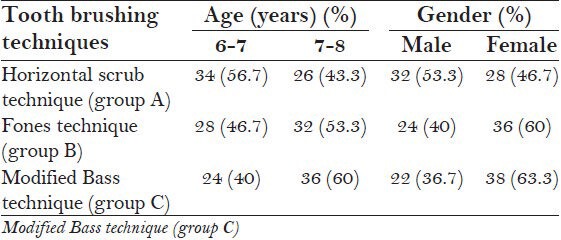
RESULTS
Plaque scores were individually compared at baseline and 24-h follow-up in each group using paired t-test. Plaque scores in group A (horizontal scrub technique) reduced from baseline score (mean = 1.228) to follow-up score (mean = 0.643), which was statistically significant (P < 0.001) [Figure 1]. Plaque scores in group B (Fones technique) reduced from baseline score (mean = 1.299) to follow-up score (mean = 0.8125), which was also statistically significant (P < 0.001) [Figure 2]. Plaque scores in group C (modified Bass technique) reduced from baseline score (mean = 1.274) to follow-up score (mean = 0.4456), which was statistically significant (P < 0.001) [Figure 3].
Figure 1.
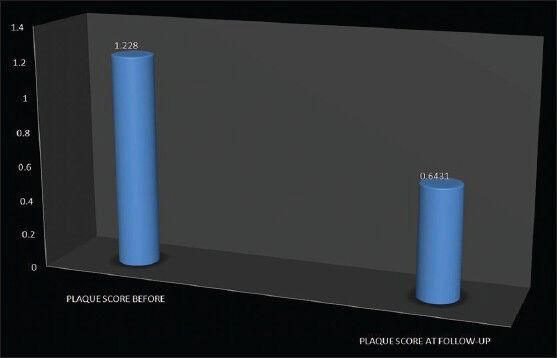
Plaque scores before and after use of horizontal scrub technique
Figure 2.
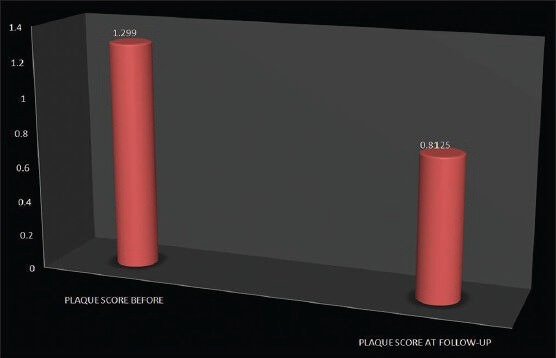
Plaque scores before and after use of Fones technique
Figure 3.
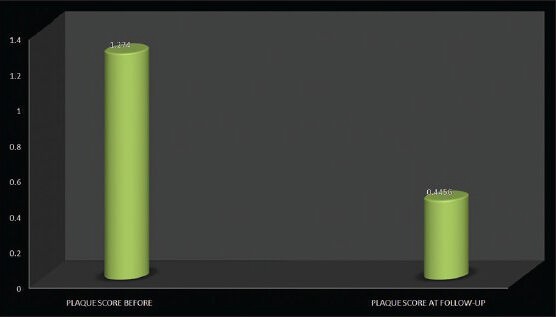
Plaque scores before and after use of modified Bass technique
Comparison was made between the three groups for plaque scores at baseline and 24-h follow-up [Figure 4] and the results were analyzed using single ANOVA test. Baseline plaque scores of all the three groups were comparable, with no significant intergroup differences. However, statistically significant (P < 0.001) reduction in plaque score was seen in modified Bass technique followed by horizontal scrub technique and the least efficacy was seen in Fones technique.
Figure 4.
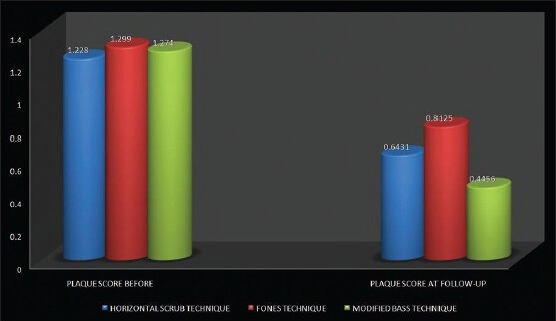
Comparison of before and after plaque scores in horizontal scrub, Fones, and modified Bass techniques
DISCUSSION
This study aimed at evaluating the efficacy of plaque removal by comparing horizontal scrub, Fones, and modified Bass techniques of brushing in 1st and 2nd grade school children in the age group of 6–8 years. Majority of the children in this study spontaneously used variations of the horizontal scrub technique. Several studies have reported the use of the horizontal scrub technique to be the method of choice in young children because of the inability to apply other tooth brushing methods.[6,7,8] The authors suggested that horizontal scrub technique is a suitable way of tooth brushing in preschool children, considering the development of motor skills at that age.[7,8]
Tooth brushing skill and the required manual dexterity for tooth brushing are developed in children aged 8 years and above.[9] Mescher et al.[10] suggested tooth brushing requires hand functions that are beyond the ability level of children of age 6 years and younger, and finally concluded that children aged 8 years and above could master the skills required for sulcular brushing.
Direct communication through the dentist is one of the most effective and essential ways of improving the oral health status.[11] Acharya et al.[12] observed that demonstration of oral hygiene measures using child as a model was found to be the most effective motivational tool in improving the oral hygiene and gingival health status. In the present study, each child in different groups was individually demonstrated one of the three brushing techniques through direct communication in the classroom setting using child as a model and then was encouraged brushing twice a day following the advised brushing technique. Similar methodology was followed by McCauley et al.[13] in their study who concluded that upper elementary grade children, given a 4-week course of instruction in dental health that included brushing teeth in the classroom, exhibited an improved general state of dental and oral cleanliness.
In the present study, plaque removal efficacy was significantly high with modified Bass technique followed by horizontal scrub technique and the least effective was Fones technique. These findings are in accordance with those of Kropfl[14] who stated that though the modified Bass method and modified scrub method seemed to be the methods most commonly recommended for tooth brushing, the plaque removal efficacy of modified Bass was significantly more than horizontal scrub method. Kremers et al.[15] and Zhang et al.[16] showed that interdental plaque was effectively removed by Bass technique than the other techniques. This might be the reason why modified Bass technique was most effective in plaque removal as compared to the other two techniques in the present study. This justification is in accordance with the results of McClure[7] and Sangnes et al.,[17] who concluded that modified Bass technique was efficacious in removal of interdental plaque. However, in visually impaired students, Smutkeeree et al.[18] observed that modified Bass and horizontal scrub methods both effectively reduced plaque index and gingival index with no significant difference between them.
In our study, horizontal scrub technique was found to be effective in removing plaque as compared to Fones technique. Similarly, Anaise[19] observed that horizontal scrubbing method has more significant plaque-removing effect than the Roll, Charters, and modified Stillman methods.
In our study, the plaque removal efficacy was found to be least in group C (Fones technique group). The probable reason might be ineffective interdental plaque removal using Fones technique. Our results are in accordance with those of Arai et al.[20] who observed that plaque removal efficacy was least in Fones technique, but it was found to be the most easily learnt technique in children. However, contrasting results were obtained by Wilkins[4] who recommended Fones technique of tooth brushing for school aged children as it is an easily learnt and effective technique of tooth brushing.
CONCLUSION
This study showed that modified Bass technique was the most effective brushing technique followed by horizontal scrub technique and the least effective was Fones technique. Oral hygiene instruction should be according to a child's development stage and motor skill. Variations in the ability of tooth brushing must be considered, especially with younger children. Intensive individual training of each child is also essential to achieve desired benefits of the technique.
Footnotes
Source of Support: Nil
Conflict of Interest: None declared.
REFERENCES
- 1.Das UM, Beena JP, Azher U. Oral health status of 6- and 12-year-old school going children in Bangalore city: An epidemiological study. J Indian Soc Pedod Prev Dent. 2009;27:6–8. doi: 10.4103/0970-4388.50809. [DOI] [PubMed] [Google Scholar]
- 2.Robinson E. A comparative evaluation of the Scrub and Bass Methods of toothbrushing with flossing as an adjunct (in fifth and sixth graders) Am J Public Health. 1976;66:1078–81. doi: 10.2105/ajph.66.11.1078. [DOI] [PMC free article] [PubMed] [Google Scholar]
- 3.Kolawole KA, Oziegbe EO, Bamise CT. Oral hygiene measures and the periodontal status of school children. Int J Dent Hyg. 2011;9:143–8. doi: 10.1111/j.1601-5037.2010.00466.x. [DOI] [PubMed] [Google Scholar]
- 4.Wilkins EM. 8th ed. Philadelphia: Lippincott Williams and Williams; 1999. Clinical Practice of the Dental Hygienist; p. 453. [Google Scholar]
- 5.Löe H. The gingival index, the plaque index and the retention index system. J Periodontol. 1967;38(Suppl):610–6. doi: 10.1902/jop.1967.38.6.610. [DOI] [PubMed] [Google Scholar]
- 6.Kimmelman BB, Tassman GL. Research in design of children's toothbrushes. J Dent Child. 1960;27:60. [Google Scholar]
- 7.McClure DB. A comparison of toothbrushing technics for the preschool child. J Dent Child. 1966;33:205–10. [PubMed] [Google Scholar]
- 8.Rugg-Gunn AJ, Macgregor ID. A survey of toothbrushing behaviour in children and young adults. J Periodontal Res. 1978;13:382–9. doi: 10.1111/j.1600-0765.1978.tb00193.x. [DOI] [PubMed] [Google Scholar]
- 9.Das UM, Singhal P. Tooth brushing skills for the children aged 3-11 years. J Indian Soc Pedod Prev Dent. 2009;2:104–7. doi: 10.4103/0970-4388.55335. [DOI] [PubMed] [Google Scholar]
- 10.Mescher KD, Brine P, Biller I. Ability of elementary school children to perform sulcular toothbrushing as related to their hand function ability. Pediatr Dent. 1980;2:31–6. [PubMed] [Google Scholar]
- 11.Chachra S, Dhawan P, Kaur T, Sharma AK. The most effective and essential way of improving the oral health status education. J Indian Soc Pedod Prev Dent. 2011;29:216–21. doi: 10.4103/0970-4388.85825. [DOI] [PubMed] [Google Scholar]
- 12.Acharya S, Goyal A, Utreja AK, Mohanty U. Effect of three different motivational techniques on oral hygiene and gingival health of patients undergoing multibracketed orthodontics. Angle Orthod. 2011;81:884–8. doi: 10.2319/112210-680.1. [DOI] [PMC free article] [PubMed] [Google Scholar]
- 13.McCauley HB, Davis LB, Frazier TM. Effect on oral cleanliness produced by dental health instruction and brushing the teeth in the classroom. J Sch Health. 1955;25:250–4. [Google Scholar]
- 14.Kropf JL. Clinical Evaluation of Magnifying Lighted Mirror and Unwaxed Dental Floss as Oral Hygiene Adjuncts. Master's Thesis, Ann Arbor, University of Michigan, School Dentistry. 1971:124. [Google Scholar]
- 15.Kremers L, Lampert F, Etzold C. Comparative clinical studies on 2 toothbrushing methods--Roll and Bass technic. Dtsch Zahnarztl Z. 1978;33:58–60. [PubMed] [Google Scholar]
- 16.Zhang JH, Sha YQ, Cao CF. Comparative study of the effects of removing plaque by two toothbrushing methods. Beijing Da Xue Xue Bao. 2005;37:542–4. [PubMed] [Google Scholar]
- 17.Sangnes G, Zachrisson B, Gjermo P. Effectiveness of vertical and horizontal brushing techniques in plaque removal. ASDC J Dent Child. 1972;39:94–7. [PubMed] [Google Scholar]
- 18.Smutkeeree A, Rojlakkanawong N, Yimcharoen V. A 6-month comparison of toothbrushing efficacy between the horizontal Scrub and modified Bass methods in visually impaired students. Int J Paediatr Dent. 2011;21:278–83. doi: 10.1111/j.1365-263X.2011.01120.x. [DOI] [PubMed] [Google Scholar]
- 19.Anaise JZ. The toothbrush in plaque removal. ASDC J Dent Child. 1975;42:186–9. [PubMed] [Google Scholar]
- 20.Arai T, Kinoshita S. A comparison of plaque removal by different toothbrushes and toothbrushing methods. Bull Tokyo Med Dent Univ. 1977;24:177–88. [PubMed] [Google Scholar]


